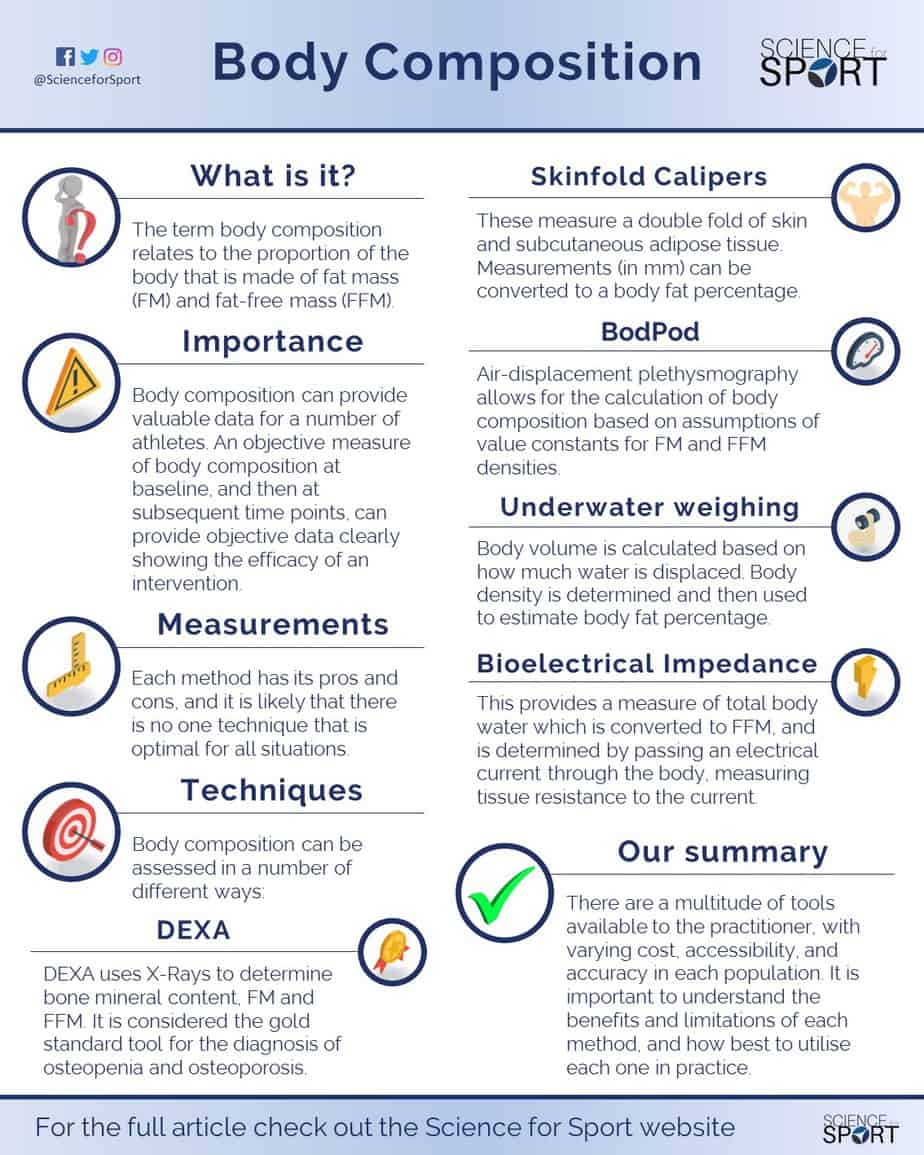
Laboratory Measurement Of Body Composition
The measurement of body composition occurs in many branches of biology and medicine. Ongoing efforts involve multisegmental and multifrequency bioelectrical impedance analysis quantitative magnetic resonance for total body water fat and lean tissue measurements imaging to further define ectopic fat depots. Laboratory measurements of body composition densitometry the application of densitometry to the measurement of human body composition is based on the principle that if thebodyisregardedasbeingmadeupoftwocomponents ofknowndensitiesthenthebodydensityisdeterminedby the relative proportions of the two components. There is a multitude of established methods and techniques for in vivo estimation of body composition ranging from simple field methods for example skinfold measurement to laboratory methods such as dual energy x ray absorptiometry dxa hydrostatic weighing and the more complex in vivo neutron acti vation analysis. The simplest approach in body composition is the 2c model dividing body weight into fat mass fm and fat free mass ffm. Common methods for body composition assessment include hydrostatic.
This measurement includes all of the elements of your body bones blood organs muscles and fat. The cnrc body composition laboratory is the only laboratory of its type in the nation that can provide a complete complement of body composition measurements in all populations ranging from low birth weight infants to adults. Our laboratory utilizes 2 devices for this measurement. Impedimed sfb7 and the inbody 720. Body composition can be estimated by measuring total body water. The purpose of the body composition laboratory is to conduct research in the area of body composition and carry out measurements of body composition and energy expenditure to monitor growth nutritional status rehabilitation and energy requirements in a variety of clinical conditions.
Body composition refers to the relative percentages of body weight comprised of fat and fat free body tissue. Weight is an overall measure of your body mass. A multi frequency unit bis. The anhydrous fm is the chemically extractable fat with an assumed density of 09007 gcm3 whereas the ffm is assumed to have a density of 11000 gcm3and water content of 7372 per cent7. A quick google search will reveal a number of different ways to measure body mass and composition. Energy stores skeletal muscle and protein content can be determined and changes monitored.
Assessment techniques vary from simple field measurements to elaborate laboratory techniques that require expensive equipment and specially trained technicians. These high precision measurements are associated with body water mineral protein and fat content. Body composition measurement methods are continuously being perfected. At any rate these 9 indicators are some of the most important factors to consider. These devices provide details of intra and extracellular fluid as well as fat mass fat free mass and percent body fat. It is used in the assessment of nutritional and growth status and in disease states and their treatment.
Random Post
- measurement body hunter mcgrady
- barbie forteza body measurement
- hala al turk body measurements
- sonal chauhan body measurement
- amir khan boxer body measurements
- sara arjun body measurement
- lita body measurements
- us navy body fat measurement
- body measurements image creator
- raashi bawa body measurement
- body measurements figure size
- female body measurement chart printable
- the perfect woman's body measurement
- shu qi body measurement
- body jewelry measurement guide
- lea michele body measurement
- body measurement tiktok
- camille trinidad body measurement
- weight and body measurement tracker app
- victoria secret body measurement requirements
- faster way to fat loss body measurements
- body measurement for ladies trousers
- body measurement input
- athlean x body fat measurement
- kiccha sudeep body measurement
- meg donnelly body measurement
- soft body measurement
- which of the following is the most accurate measurement of body temperature
- types of body measurement
- lena headey body measurements
- kanwal aftab body measurement
- rxz body measurement
- sajal ali body measurement
- jaya bachchan body measurement
- bra measurement to
- rsx body measurement
- valenti vitel body measurement
- mallika singh body measurement
- twice member body measurement
- body fat measurement bangalore
- how to take measurement of bra size
- madhubala body measurement
- bhavana body measurements
- sargun mehta body measurement
- body measurements fitness
- bra and cup size measurement
- candice accola body measurement
- body shape calculator shoulder measurement
- shobha shetty body measurement
- body measurement amina boutique













/underwater-hydrostatic-body-fat-weighing-453131436-5ad4f5c2642dca0036367079.jpg)







/genetic-engineers-weighing-chemicals-out-142573375-5c7fd72246e0fb00011bf401.jpg)







/GettyImages-180403783-59036e885f9b5810dc0611b2.jpg)







